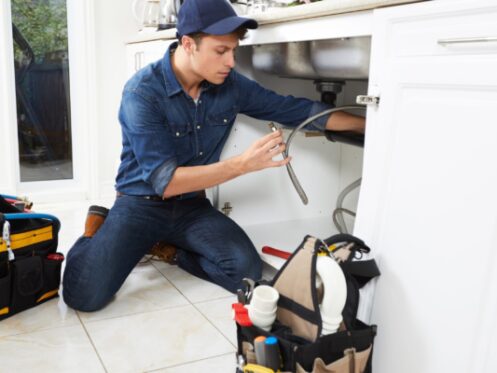Many homeowners don’t give much thought to the condition of their plumbing until an issue presents itself. These issues can arise as a clogged drain, leaky faucet, or even standing water on a basement floor. Whatever the reveal, it calls attention to the fact that our plumbing systems have an expiration date, and yours may be rapidly approaching.
What Is Repiping?
Repiping is the process of replacing the existing pipes in a home. It involves removing old, dysfunctional pipes and installing new ones made of copper, PEX, or PVC. Repiping is done for a variety of reasons, including:
- Old or outdated fixtures
- Corrosion and leaks that compromise water quality
- Broken or clogged lines that stubbornly resist clearing
Repiping is a disruptive and time-consuming process, but it is often necessary to ensure the long-term functionality and safety of your home’s plumbing system.
Reasons Why Your Home May Need Repiping
You will know it’s time to consider repiping when the following issues occur, some of which may be potentially dangerous to your health and your loved ones. Taking prompt action to schedule service is recommended to minimize damage to your home and to protect your family from contaminated water and contact with harmful pathogens.
1. Constant Clogging
When deciding whether to repipe your home, assess how your pipes have been performing for you. Older homes with pipes that are decades old are more prone to clogging and complete blockages. They may even have difficulty handling toilet paper, one of the most easily biodegradable substances on the planet. If you have been experiencing persistent clogging and blockage issues, a complete system overhaul may be needed.
2. Leaking Pipes
Leaky pipes can manifest in very messy ways. Pipes leaking in walls, ceilings, and under flooring can cause water damage and mold growth that can be hazardous to those with respiratory conditions. Don’t neglect your small leak and think it won’t manifest into anything significant. Take action to repair it and ask your plumbing technician if more comprehensive work on your system is needed to ensure its integrity and continued function.
3. Noise, Noise, Noise!
Noisy pipes are annoying, but there are underlying causes of those bangs and clangs that may lead to serious plumbing issues later. Rattling and gurgling indicate there are blockages that flowing water must work hard to overcome.
4. Decreased Water Pressure
If you notice lower water pressure when turning on faucets and showers, you may have corrosion and buildup issues preventing adequate water pressure. As corrosion continues to form, this can put you at risk of experiencing a burst pipe that could cause significant water damage in your home.
5. Colored Water
Yellow, red, or brown water spells trouble for your plumbing system down the line. These colors are all indicators that there is sediment in your system. Over time, this will become a buildup that will require a professional to repipe your plumbing fixtures.
6. Water Temperature Issues
If you crank your faucets to the hottest setting yet are getting the cold shoulder, it may be time for appliance and pipe replacement.
The Repiping Process: The Basics
Much like your body, your home has internal systems you can’t see, yet you rely on for creature comforts such as hot and cold running water. Your plumbing system has several functions. It moves hot and cold water to various places in your home, provides clean water, and removes waste to a city or septic sewer system for safe disposal. Over time, this intricate network of pipes and connections can wear down, develop leaks and cracks, and form blockages that make portions of your system nonfunctional.
When a pipe is damaged, you may choose to repair or replace only that section of your system. However, other pipes may be developing issues that you can’t see. Repiping allows for a fresh start, saving you money on intermittent repairs while ensuring the functionality and efficiency of your plumbing.
Repiping involves the following steps, and each phase is essential to a complete and thorough job:
1. Inspection
An inspection will be conducted by a plumbing professional who will listen to you describe your plumbing issues and look for signs of trouble. After a comprehensive look at your system, the technician will likely offer advice on beginning the repiping process.
2. Estimate and Recommendations
Depending on your home’s age, layout, and other relevant information, your technician will craft a timetable that includes purchasing materials and putting a work plan in place. A qualified plumbing contractor will provide you with a comprehensive estimate that includes demolition, work scope, and reconstruction costs so you can see what will be necessary before the job begins. Asking for several estimates is recommended, as you should feel comfortable with the plumbing professional you choose and the amount they charge for work completed.
3. Demolition
Once a contractor and an estimate have been agreed upon, it’s time for demolition. A good plumbing contractor will go to great lengths to protect your home and valuables from demolition and water damage. They will likely be taking out sections of walls with old piping, so don’t be surprised to see it get a bit messy before things begin taking shape once more.
4. Plumbing and Repiping
With demolition completed and your plumbing areas prepped, it’s time to install new piping. Your new pipes might consist of copper, PEX, or PVC. Ask questions of your contractor to see what type of material fits your home and your needs. Your new pipes will be fitted and connected, and water pressure tests will be conducted to ensure everything is in working order. Potential issues with pressure and function will be repaired before reconstruction begins.
5. Reconstruction
Once all fixtures and lines have undergone testing, it’s time to begin reconstruction. Your contractor will patch up walls and restore flooring, paint, and wall coverings as needed to make your home clean and comfortable again.
How Much Does Repiping a Home Cost?
The cost to repipe a home can vary greatly, depending on the size of your home, the complexity of your current system, and the materials you choose for new installation. On average, the cost of repiping ranges from $1500 to more than $15,000. Get an estimate from several trusted contractors to ensure you find a price and professional that makes you comfortable.
Watch the Magic Happen!
Repiping is a significant and costly undertaking for any homeowner, yet it is necessary to maintain and preserve your plumbing system’s function. High 5 Plumbing has been serving valued clients in the Denver area and beyond with services such as plumbing maintenance, repair, and repiping; water heater installation, maintenance, and repair; drain and sewer line cleaning; and much more. We’ll get you flowing freely once more with the expertise of our highly skilled technicians. Contact High 5 Plumbing today for a comprehensive assessment of your system and to learn more about the repiping process!


